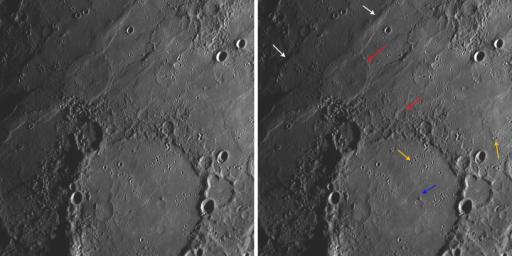
|
One Month Ago…
- Click the image above for a larger view
- Full-Res JPEG (2050 x 1024) (332.2 kB)
- Full-Res TIFF (2050 x 1024) (6.3 MB)
Caption:
One month ago, on January 14, 2008, MESSENGER became the first spacecraft in over three decades to visit Mercury, snapping images of a large portion of Mercury's surface previously unseen by spacecraft. As the spacecraft proceeds on its journey, the science team continues to study the 1213 images returned from the mission's historic first flyby. The probe's trajectory will bring it to a second Mercury flyby on October 6, 2008.
MESSENGER's Narrow Angle Camera (NAC) of the Mercury Dual Imaging System (MDIS) captured this image during the flyby one month ago. The Sun is illuminating this region at a low angle, accentuating the modest ridges and other low topography on these nearly flat plains. Low ridges trend from the top-center of the image to the left edge (white arrows). The ghostly remains of craters are visible, filled to their rims by what may have been volcanic lavas (red arrows). The faint remnant of an inner ring within the large crater in the bottom half of this picture can be seen (blue arrow); the area interior to this ring was also flooded, possibly by lava, nearly to the point of disappearance. Clusters of secondary craters on the floor of the large crater and elsewhere (yellow arrows) formed when clumps of material were ejected from large impacts beyond the view of this image, which is about 350 kilometers (220 miles) across.
Image Mission Elapsed Time (MET): 108826972
Background Info:
These images are from MESSENGER, a NASA Discovery mission to conduct the first orbital study of the innermost planet, Mercury. For information regarding the use of images, see the MESSENGER image use policy .
Cataloging Keywords:
| Name | Value | Additional Values |
|---|---|---|
| Target | Mercury | |
| System | ||
| Target Type | Planet | |
| Mission | MESSENGER | |
| Instrument Host | MESSENGER | |
| Host Type | Orbiter | |
| Instrument | Mercury Dual Imaging System (MDIS) | |
| Detector | Narrow Angle Camera (NAC) | |
| Extra Keywords | Color, Crater, Impact, Volcano | |
| Acquisition Date | ||
| Release Date | 2008-02-14 | |
| Date in Caption | 2008-01-14 | 2008-10-06 |
| Image Credit | NASA/Johns Hopkins University Applied Physics Laboratory/Carnegie Institution of Washington | |
| Source | photojournal.jpl.nasa.gov/catalog/PIA10601 | |
| Identifier | PIA10601 | |
